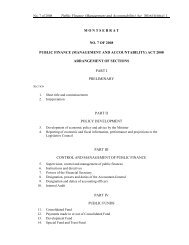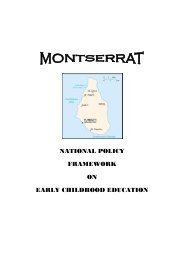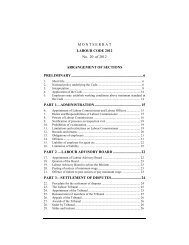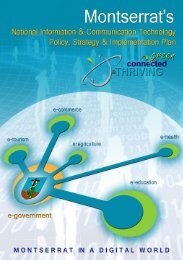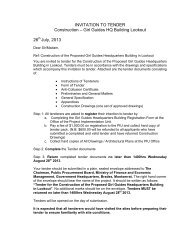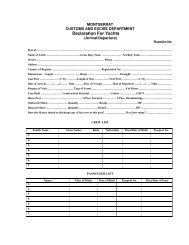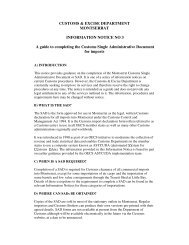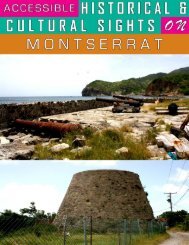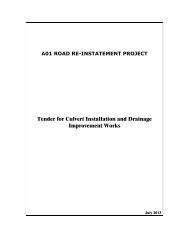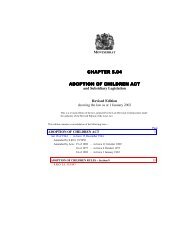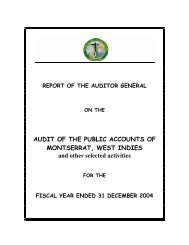Montserrat Survey of Living Conditions (MSLC) Executive Summary
Montserrat Survey of Living Conditions (MSLC) Executive Summary
Montserrat Survey of Living Conditions (MSLC) Executive Summary
Create successful ePaper yourself
Turn your PDF publications into a flip-book with our unique Google optimized e-Paper software.
<strong>Montserrat</strong> <strong>Survey</strong> <strong>of</strong> <strong>Living</strong> <strong>Conditions</strong><strong>Executive</strong> <strong>Summary</strong>the one hand and policies and programmes to improve the quality and coverage <strong>of</strong> government services.There also appears, given the small size <strong>of</strong> the island, little scope for private public partnerships, althoughthese may come if there is a policy to outsource government services.For these reasons, the likelihood <strong>of</strong> GOM taking out CDB loans appears remote in the short and mediumterms; this inevitably reduces the scope for CDB assistance to the island. In these circumstances, thereappear to be two main ways in which CDB can contribute to <strong>Montserrat</strong>’s future development:By continuing to provide funds to BNTF programmes on the island but with a greater emphasison social rather than infrastructure projects.By partnering with DFID on social programmes: DFID is the most important provider <strong>of</strong>assistance to <strong>Montserrat</strong>, and is likely to remain so. Social issues are high on its agenda. Whilesome <strong>of</strong> these require capital investment, the priority is for training, capacity building, publicawareness raising and innovative ways <strong>of</strong> tackling social issues. CDB should consider workingwith DFID to develop, fund and implement these types <strong>of</strong> initiative.Not specific to <strong>Montserrat</strong>, the study team also recommends that CDB promotes Caribbean-wide researchinto:The analysis <strong>of</strong> census data to provide more fine-grained information on the structure <strong>of</strong>households, particularly those containing children and elderly persons.Male attitudes and aspirations in relation to fatherhood and spousal relationships.Developing innovative approaches to social issues.6.11 Monitoring and EvaluationMonitoring poverty levels is critical if the effectiveness <strong>of</strong> government policies and programmes is to beassessed. Yet the best way <strong>of</strong> providing information on poverty levels - sample household surveys - arecostly and time consuming. Accordingly an annual reporting system should be developed using proxyindicators changes in poverty levels. Potential indicators are: water and electricity bill arrears anddisconnection rates, recipients <strong>of</strong> social welfare services (including the number <strong>of</strong> ‘rejected’ applicants), theincidence <strong>of</strong> children going to school hungry. The M and E system also needs to include an evaluation <strong>of</strong>PAP activities and their effectiveness.7 Concluding RemarksReviewing the Study’s findings and recommendations, three facts stand out. The first is that the principalcause <strong>of</strong> continuing poverty on <strong>Montserrat</strong> is the economy – about which the government can dorelatively little. The second is that the coverage and service <strong>of</strong> physical and social infrastructure is not amajor issue, and does not appear likely to become one unless financial support from the BritishGovernment is withdrawn - which also appears unlikely. The third is that many <strong>of</strong> the concerns raisedapply to small, discrete groups <strong>of</strong> the population, e.g. the elderly on their own, women and children at riskfrom violence, teenage mothers, unemployed <strong>Montserrat</strong>ians, etc.<strong>Montserrat</strong> Country Poverty Assessment, Final ReportHalcrow Group Limited, July 2012.ES31




